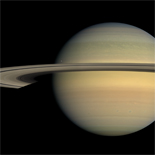
(NASA/JPL/SSI)
Astronomy 309S - Spring 2010
THE SOLAR SYSTEM
MWF 11:00-12:00 · WEL 3.502 · Unique No. 49035
Professor
Sally Dobson-Robinson
RLM 17.218 · (512) 471-7774 · email
Courses - Spring '10 | Course Website
Course schedule
Unit 1: Introduction and solar system formation
Solar system inventory: names and definitions of planets, asteroids, moons, comets and Kuiper Belt Objects.
Setting the scale: relative sizes of objects in the solar system, distances between them, distance to nearby stars
Why we have planets: star formation and protostellar disks
Assignments due: January 27, February 5
Quiz 1: Monday, February 8
Unit 2: Terrestrial planets
Formation, composition and size
Geological processes: plate tectonics, volcanism and the carbon cycle
The cratering record and the Late Heavy Bombardment
The moon-forming impact: ongoing research
Assignments due: February 17 and 26
Quiz 2: Monday, March 1
Unit 3: Giant Planets
Formation, composition and size: ongoing research
Differences between gas giants (Jupiter and Saturn) and ice giants (Uranus and Neptune)
Rotation, magnetic fields and storms
Moons and rings
Assignments due: March 10 and 26
Quiz 3: Monday, March 29
Unit 4: Leftovers
The Kuiper Belt: Pluto, Eris, Quaoar and why there are now 8 planets
Asteroids: sizes, orbits, encounters with Earth, mass extinctions
The science of meteoritics: measuring the age of the solar system, possible evidence for life on Mars
Comets: leftovers from giant planet formation
Assignments due: April 5 and 14
Quiz 4: Friday, April 16
Unit 5: Exoplanets
What we have discovered: hot Jupiters, planetary supergiants, Neptunes and super-Earths
How to find planets
The search for habitable worlds
Life in the universe
Assignments due: April 26, May 5
Quiz 5: Friday, May 7
Final Exam: Friday, May 14, 9:00 AM-12:00 PM